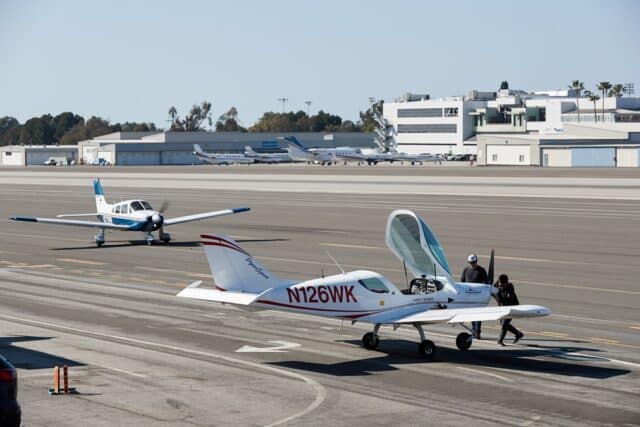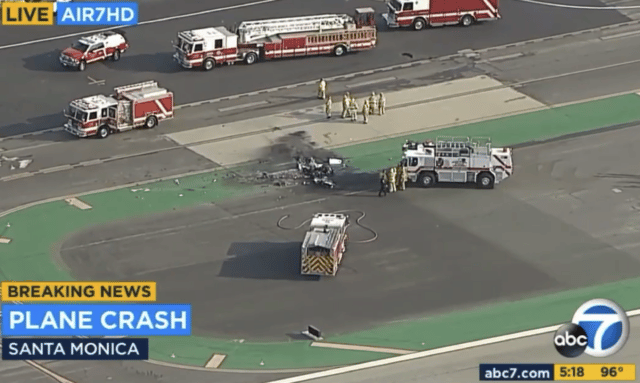Fatal Crash of LSA at Santa Monica Airport
Yesterday at around 16:30 local time, a light sports aircraft crashed onto the runway of Santa Monica Airport (SMO) in California. The aircraft was a CSA SportCruiser, a two-seater aircraft also sometimes known as a PiperShort. The SportCruiser belonged to a flying school based at the airport. Initial reports are that a 15-year-old was on a discovery flight with a Certified Flight Instructor (CFI).

A discovery flight is typically around half an hour in the air and used as a flight introduction for those considering learning to fly. Typically, a discovery flight will include a pre-flight briefing and walkaround, followed by a brief flight with the instructor in control. Once at a safe altitude, the passenger may be invited to take control for basic turns and altitude changes. The instructor will again maintain control for the descent and the landing.
It’s an opportunity to discover how you feel about the responsibilities of being a pilot in a small aircraft and also can be used to get a feel for the flying school, although the instructor for your discovery flight may not be the instructor that is assigned to you for your lessons.
The ASDB information from FlightAware shows a typical discovery flight, following the coast out to Malibu and Point Dume before circling back towards the airport, with a large turn over the water a few miles out from Santa Monica.
I’m torn about linking to the audio from LiveATC, which consists of 25 minutes of normal ATC audio followed by a voice screaming, “Let go! Let go!” directly before the crash. I’m not going to embed it into the post as it is truly disturbing to listen to, but for those interested, here is a direct link to the heartbreaking audio on LiveATC.
For the rest, I have summarised the recording.
Relatively early on, we hear the flight instructor tell the controller that they are inbound to land (“full stop”). Then, at around the 24:40 point, the controller clears a King Air for take-off and asks the inbound flight to report the King Air in sight.
Once the instructor has confirmed they have the King Air in sight, the controller cautions against wake turbulence and asks the inbound flight to maintain visual separation to the King Air.
The controller clears the flight “for the option,” which means that the flight is cleared to use the runway at the instructor’s discretion. This includes a full-stop landing, as the instructor had requested, but also allows the flight to do a touch-and-go, a stop-and-go or a missed approach. Effectively, the runway situation is clear enough that the training flight can even come to a complete halt on the runway and take off again, if the instructor wishes.
The instructor reads back the instructions and that they are cleared for the option.
As the King Air becomes established in the climb, about two minutes after the take-off clearance, the controller asks the departing aircraft to change to the departure frequency.
The next broadcast is of incoherent sounds and a voice clearly shouting, “Let go, let go, let go!”
From there, it is a jumble of calls until 26:45, as the controller, who seems to be clinging to his professionalism by a thread, explains to an inbound flight that there has been a crash on the field and that the airport is going to be closed for quite a while.
About a minute later, a helicopter pilot states that they have a medic and a doctor on board and asks whether they could be of any help.
The controller, sounding a bit shell-shocked, says he’s not sure and that he’s waiting for a report from those on the ground, but then admits that he doesn’t expect any survivors.
Initial media footage shows the devastation of the crash.
Breaking News Plane Crash on Runway In Santa Monica @RoadSageLA Reports pic.twitter.com/nxc8sbAFLH
— PupScanLA (@PupscanLA) September 9, 2022
One report says that the aircraft “pitched aggressively nose up” shortly after crossing the threshold for a full-stop landing.
The aircraft climbed steeply and then fell approximately 100 feet and crashed onto the runway. Another eyewitness described the aircraft as starting to stall before entering a spin to the left.

Initially, it seemed like the crash may have been caused by wake turbulence but this description, along with the audio, sounds very much like the student grabbing the controls while close to the ground and pulling the light aircraft into a stall.
The NTSB has started an investigation and the preliminary report should be released in a month.








Ugh. I wonder what options the NTSB has to try to determine who was in “control”
I wouldn’t expect there to be any forces large enough to leave evidence.
One thing I suspected, which has now been confirmed, is that the instructors at that school do not have first-time students “follow-through” with their hands on the controls during landing.
It seems unlikely that the NTSB will be able to make any more sense of it, as the aircraft appears to be largely destroyed and almost certainly did not have a CVR installed.
Gene is right: there may not enough in the way of evidence to establish what lead to this crash.
In my early days as a commercial pilot, the only work available at the time was banner towing, towing a banner with an advertisement.
This was in Germany, where I was promoted to “Verbandsfuhrer” (formation leader), in charge of a formation of 3 Piper Super Cubs towing individual segments to make up an advertising slogan.
One pilot was Norwegian. He had substantial facial disfigurements and had undergone extensive reconstructive surgery.
He had been a CFI when with a student, doing a spinning exercise, the student froze at the controls. He was considerably stronger than his instructor, let’s call him “Olav” (not his real name). They spun into a lake. Olav suffered serious injuries, it was a long time ago so I am not sure whether or not the student survived.
Eventually Olav recovered from his injuries. Obviously the cause had been established, Olav was cleared and his licence was re-issued.
Unfortunately Olav never recovered fully: he had become nervous and during a routine banner flight, switching from an empty tank to the full one (we waited until the engine cut out to get the maximum out of our endurance, he panicked and kept changing from full to empty and back.
The nearest aerodrome brought us straight through a military firing range. A “prohibited area”. I had to declare an emergency to get the firing stopped,
The Super Cub landed with one tank empty and the other one full. Olav, sadly, was dismissed.
At least, on this flight there were no deaths or injuries.
I’m relieved to hear that “Olav” survived, that could have had quite a different outcome.
I’m surprised there isn’t a way to simply disengage the student set of controls at the push of a button. It would add a little weight to the aircraft, but it would help prevent panicking students from causing catastrophes.
The problem is that it is yet another thing that can break. Your button is the easy bit, disconnecting the controls is huge. It adds a whole new axis of catastrophes that can happen.
He was not 15 by the way, he was 28. This was my friend from college. Really beautiful person, my condolences to everyone affected.
I’m sorry for the error and especially for your loss.
There was only 30 seconds from the time the King Air rolled and the scream. This was 100% wake turbulence! The instructor sounded relaxed and to me a bit complacent when he saw the king Air on the runway. He should have requested a go around or a 360 on final to allow the prop wash to dissipate. In addition the King Air delayed on the runway (no fault there) but the instructor pilot should have been very concerned with this delay. Not enough time passed. Tragic but avoidable. The “let go” statement is any ones guess but the 30 seconds is fact and evidence shows wake turbulence is the primary probable cause.
Wake turbulence causes a downward force. This aircraft pitched up severely and entered a spin to the left. This definitely appears to be a low level cross control, power on stall in an aircraft that is very unforgiving of such a severe input.
In any case, the King Air wouldn’t have been airborne until well past the touchdown zone at SMO. There is no displaced threshold and the runway is now, sadly, only 3500′. They probably wouldn’t even rotate until past 1000′ down the runway and certainly wouldn’t be 100′ in the air.
Wake turbulence is generated not only from the wing tip vortices but also from the propeller tips. The KA stayed idling in a line up and wait position creating a situation that disturbed the air right at the touchdown point of the Light sport. I speak from experience and I encourage all pilots reading this to allow at least a 2 minute separation between when the AC on the runway starts to roll to landing. Wake turbulence caused this accident.
Seriously doubt it was WT. A king air needs maybe 2000-2500 feet to rotate and generate lift, which is when WT begins. The Cruiser barely made it over the threshold, Wake turbulence would also cause a roll, but not a violent pitch up.
Wake Turbulence is an all encompassing term which includes jet or prop wash as well. He should have gone around. He experienced something like this but worse:
https://youtu.be/N-XDkVyICF8
Perhaps he applied too much throttle to compensate at the last second which possibly pitched them up but my point is that he should have gone around…full stop.
Or this one…perhaps we should use the term “prop wash” which disturbed the air prior to them landing… https://youtu.be/tZLXMKMgnS8
No helicopters don’t have “wing tip voticies” but they have prop wash which the king air did too. So I correct myself – prop wash is what brought this plane down. When ATC states caution: wake turbulence, I consider prop wash to be included in this all encompassing warning.
I’ve experienced WT more times than I care to admit. One time it turned me completely upside down – violently up pitching me however I had altitude to recover; sadly they didn’t. I pitched UP I I was never more scared in my life.
How did you encounter WT at a high altitude?
An airliner 500 feet above me,
Watch:
https://youtu.be/ZI9ZHBRc2yQ